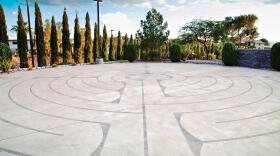[sustainability]
Growth spurt
It's a well-polished platitude that the Southern Nevada housing market's collapse is an opportunity to pause and decide what kind of community we really want to be. Hmm. Let's see. Hyperbolically churning, stucco-armored growth machine? Been there, done that. How about a resource-savvy desert metropolis that respects its place in the Southwest? Yes, please. Some local developers are starting to bring that very vision to life.
Near Charleston Boulevard and the 215 Beltway, Pulte Homes is about 30 houses into its 185-home Villa Trieste development. From the outside? Looks like a typical subdivision. The guts, however, are among the greenest in town. Homes include a solar-electric system built into the roof, a touch-screen dashboard that tracks energy use, a tankless water heater and a tightly insulated shell, all of which promises to slash energy bills by up to 60 percent. "When I started working for Pulte 10 years ago, talking about energy efficiency came down to using, say, sustainable wood floors or better insulation," says Lindsay Motley, vice president of sales for PulteGroup's Las Vegas Division. "There was no concept of an integrated solar system, or being able to (assess your energy use) from your iPhone."
If Pulte's Villa Trieste - which earned a gold certification from Leadership in Energy and Environmental Design - sounds like a science project, that's because it is. Those upgrades were subsidized by a $7 million federal grant to Pulte, the UNLV Center for Energy Research and NV Energy. But the real gold will be in making this green tech affordable for the average homebuyer. In Centennial Hills, Meritage Homes is trying just that, having completed a model "Meritage Green" home that's also 60 percent more energy efficient than typical tract house - for prices starting at $150,000.
At the other end of the valley, boutique builder Blue Heron is breaking ground on a new development in an improbable market: sustainable luxury homes. Its latest development, Marquis Seven Hills, boasts passive solar design and a rainwater-collection system, among other perks. "People have different reasons for wanting an energy efficient home," says Tyler Jones, a principal with the firm. "Some are interested in doing the right thing by the planet, others are concerned with paying less in the long term, but the appeal is becoming universal."Even green architect Rick Van Diepen, who designed an ultra-efficient home for Habitat for Humanity (page 52), jokingly says he stole some of these ideas. When an avant-green guru takes cues from major developers, we're living in new - and hopefully greener - times indeed.
- Andrew Kiraly
[design]
Let's kick some glass
Las Vegas tourists and locals like to drink - okay, they love to drink. No wonder the city generates more than 18 million tons of glass waste annually. Now some local companies are making a difference - and promoting fine design - by finding ways to recycle those glass bottles.
Realm of Design, a Henderson architectural reproduction company, is approaching sustainability with a plan that's artful - literally. After four years of development, this local business that produces stone mantles, columns and other pieces of art has created an architectural stone made from 99.8 percent renewable materials. Currently this stone is made from recycled glass bottles from Mandalay Bay and Luxor.
"It'll show Las Vegas and show other cities that Las Vegas can recycle and Las Vegas is conscious of all the glass bottles they use," Realm of Design president and co-owner Cindy McCombs says.
McCombs started the company with her husband Scott in 1991. Their aged stoned pieces include everything from Hoover Dam Bypass trash receptacles and benches to a mantle that appeared in rapper Lil Wayne's music video "Lollipop." McCombs explains that recycled glass bottles from the Strip could be made into environmentally friendly pieces for resort courtyards and other areas.
They're putting their money (or their glass) where their mouth is. Realm of Design's new manufacturing facility will be made of their green stone. "We went in there and did everything as green as we could do it," McCombs says.
When completed, the project will use more than 125,000 pounds of recycled glass and 125,000 pounds of pozzolan-based cement, which is created with fly ash, a by-product of burning coal. The building's design rocks in more than one way. It was inspired by a popular photo location for The Rolling Stones, at the Swarkestone Hall Pavilion in Derbyshire, England. In fact, McCombs has launched a campaign to get the The Rolling Stones to perform at the new plant."We figure if Betty White could get on 'SNL,' we could get The Rolling Stones to come to Las Vegas," says McCombs.
Info: www.realmofdesign.com.
- Gregan Wingert







